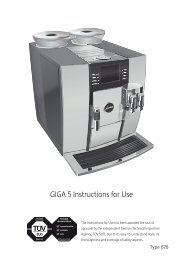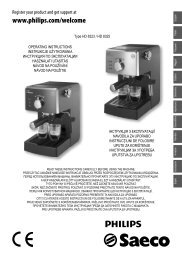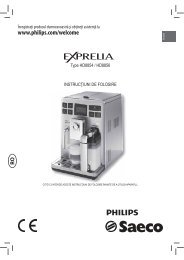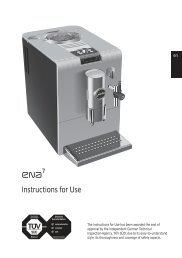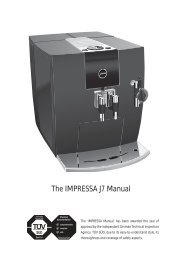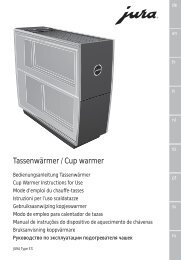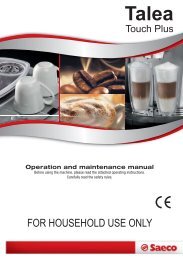Instructiuni Jetoniera RM5
Instructiuni Jetoniera RM5
Instructiuni Jetoniera RM5
You also want an ePaper? Increase the reach of your titles
YUMPU automatically turns print PDFs into web optimized ePapers that Google loves.
Coin validator<br />
<strong>RM5</strong><br />
OPERATING MANUAL
INDEX<br />
1. GENERAL INFORMATION Page 3<br />
2. WARRANTY Page 4<br />
3. COIN VALIDATOR CONNECTION Page 4<br />
- 3.1 PIN OUT OF 16 Pin STANDARD CONNECTOR Page 5<br />
- 3.2 PIN OUT OF 10 Pin STANDARD CONNECTOR Page 5<br />
- 3.3 PIN OUT OF SERIAL CONNECTOR Page 6<br />
- 3.4 WAKE-UP CONNECTOR Page 6<br />
- 3.5 SEPARATOR CONNECTION Page 7<br />
4. DIP SWITCHES Page 8<br />
5. LABEL Page 10<br />
6. MODELS Page 12<br />
7. PROGRAMMING SYSTEMS Page 12<br />
- 7.1 SELF-PROG FUNCTION Page 13<br />
- 7.2 PORTABLE PROGRAMMER Page 13<br />
- 7.3 PC KIT Page 14<br />
8. CONFIGURATION Page 14<br />
- 8.1 VALIDATOR CONFIGURATION ( <strong>RM5</strong> X 00 ) Page 15<br />
- 8.2 CC TALK VALIDATOR CONFIGURATION ( <strong>RM5</strong> X CC) Page 16<br />
- 8.3 SPAGNA VALIDATOR CONFIGURATION ( <strong>RM5</strong> X E0 ) Page 18<br />
- 8.4 TIMED PULSE VALIDATOR CONFIGURATION ( <strong>RM5</strong> X AT ) Page 19<br />
- 8.5 BINARY VALIDATOR CONFIGURATION ( <strong>RM5</strong> X B0 ) Page 20<br />
- 8.6 CONFIDA BINARY VALIDATOR CONFIGURATION ( <strong>RM5</strong> X BC) Page 21<br />
- 8.7 MULTIPULSE VALIDATOR CONFIGURATION ( <strong>RM5</strong> X 0M)<br />
- 8.8 DUAL-PRICE TOTALIZER CONFIGURATION<br />
Pag. 22<br />
( <strong>RM5</strong> X 10 ) ( <strong>RM5</strong> X 14 ) ( <strong>RM5</strong> X FD )<br />
- 8.9 CONFIGURATION OF CREDIT PULSE EMISSION TOTALIZER<br />
Page 22<br />
( <strong>RM5</strong> X 21) Page 23<br />
- 8.10 PROGRESSIVE TIMER CONFIGURATION ( <strong>RM5</strong> X 30 3R 3C)<br />
- 8.11 CONFIGURATION OF ON REQUEST CREDIT EMISSION TOTALIZER<br />
Page 25<br />
( <strong>RM5</strong> X 40 )<br />
- 8.12 CONFIGURATION OF ON REQUEST TIMED CREDIT EMISSION TOTALIZER<br />
Page 26<br />
( <strong>RM5</strong> X 60 )<br />
- 8.13 CONFIGURATION OF PHOTOCOPIER MULTIPLE SALE SINGLE PRICE<br />
Page 27 – -<br />
TOTALIZER ( <strong>RM5</strong> X 70 ) Page 28<br />
9. COIN VALIDATOR SIZE Page 29<br />
10. FRONT PANEL SIZE Page 29<br />
- 10.1 FRONT PANEL F6 Page 29<br />
- 10.2 FRONT PANEL F1 Page 30<br />
- 10.3 FRONT PANEL F3 Page 30<br />
11.REPAIR GUIDE Page 31<br />
12. SPARE PARTS Page 33<br />
13. TECHNICAL SPECIFICATIONS Page 34<br />
COMESTERO GROUP M21/03.02<br />
Rev.02<br />
of 25/09/03<br />
Page 2 of 34
1. GENERAL INFORMATION<br />
The <strong>RM5</strong> validator is the result of the investment made by Comestero to provide the market with a<br />
reliable and extremely versatile product. The project started two years before the introduction of<br />
the new European currency, the EURO.Many were the investments as well as the visits to the<br />
different European mints in order to introduce a decidedly advanced product on the market.<br />
Despite our engagement we found out remarkable differences between the different coins<br />
produced in the various mints and even among the coins of the same mint. These differences are<br />
mainly caused by the alloy, i.e. the metal used. To face this problem, i.e. making the equipment<br />
accept the highest number of Euro coins possible, although structurally different, the <strong>RM5</strong> coin<br />
validator has been equipped with 60 channels, thus increasing the possibility of adjusting up t 59<br />
different coins.<br />
The brand new electronics of the <strong>RM5</strong> validator combines the extraordinary selectivity due to<br />
seven measuring sensors to the extreme versatility thanks to the CLONING system which allows to<br />
duplicate the equipment directly on site within a few seconds.<br />
The series of <strong>RM5</strong> electronic coin validators has been designed to fully meet the different<br />
requirements of the sectors using this product. In particular:<br />
- automatic distribution<br />
- gaming and amusement<br />
- gas stations<br />
- parking areas<br />
- photocopiers<br />
- etc.<br />
The <strong>RM5</strong> Evolution series includes 10 versions with different performances to better meet the<br />
different requirements.<br />
They all have the following basic features:<br />
EVOLUTION /E0 /AT CC TALK VERSION<br />
Acceptance: 59 coins and/or different tokens 16 coins<br />
maximum acceptance speed: 3 coins/second 3 coins/second<br />
power supply + 12Vdc±10% + 12 Vdc / + 24 Vdc±10%<br />
output signals NPN OPEN COLLECTOR BC817<br />
OUTPUT LEVEL "O"<br />
LOGIC < 1.0 V<br />
Cc Talk serial protocol<br />
Cloning and reprogramming via portable programmer or NO<br />
Total disabling<br />
Personal Computer<br />
High potential on pin 6 high potential on pin 6 or via<br />
software<br />
Partial disabling via DIP-SWITCH -only first 6 Via software<br />
channels)<br />
Size 3.5 inches – See “Size of Coin validator”<br />
Each version has its specific features that can be enabled or disabled by the customer either via<br />
<strong>RM5</strong> PROGRAMMER (portable programmer) or PC program.<br />
COMESTERO GROUP M21/03.02<br />
Rev.02<br />
of 25/09/03<br />
Page 3 of 34
2. WARRANTY<br />
Our products are guaranteed for a 12-month period. The serial number on the label marks the<br />
beginning of the warranty period.<br />
The warranty will not apply in the following cases:<br />
- Tampering of the label containing the serial number of the equipment.<br />
- Breakage or malfunctioning caused by transportation.<br />
- Breakage or malfunctioning due to vandalism, natural disasters or fraudulent acts.<br />
- Incorrect or bad installation of the product.<br />
- Inadequate or anomalous electric systems.<br />
- Carelessness, negligence or incompetence in the use of the product.<br />
- Non-compliance with the operating instructions.<br />
- Interventions for alleged defects or convenient checks.<br />
Repair interventions are carried out in our Gessate premises, where the parts arrive free-of-charge.<br />
COMESTERO group will carry out no intervention whatsoever at the customer’s premises without<br />
prior agreement .<br />
Reference is anyway made to the general warranty conditions and terms that are available on<br />
request.<br />
Any returned unit for repair shall include a detailed description of the defect.<br />
The parts will be returned carriage forward or carriage charged.<br />
At the expiry of the guarantee the assistance center will remain at your disposal. Furthermore the<br />
Call Center Manager is at your complete disposal for any question you may have.<br />
3. COIN VALIDATOR CONNECTION<br />
In order to assure the highest level of compatibility with the currently available systems, the <strong>RM5</strong><br />
coin validator in th 12-24Vdc power supply version shown on the label is equipped with a standard<br />
10 Pin connector, usually powered with 12Vdc and one standard 16 Pin conector, usually powered<br />
with 24Vdc and also has the opportunity to exploit the same connectors with 12Vdc and 24Vdc<br />
power supply. Moreover the programming connector also acts as serial output which responds by<br />
sending the value of the introduced coin to the computer. Fig.1<br />
There are two different Hardware versions: <strong>RM5</strong> Evolution (standard) / EO / AT and <strong>RM5</strong> CC<br />
TALK, please refer to the images below.<br />
CONNECTOR MEANING FOR VERSIONS:<br />
EVOLUTION / E0 / AT<br />
JP5 : Wake-Up connector<br />
c CN5 : Standard 10 Pin connector<br />
CN6 : Programming connector or serial output<br />
CN7 : Standard 16 Pin connector<br />
COMESTERO GROUP M21/03.02<br />
Rev.02<br />
of 25/09/03<br />
Page 4 of 34
MEANING OF CONNECTORS<br />
FOR CC TALK COIN VALIDATOR<br />
JP5 : Empty<br />
CN5 : Standard 10 Pin connector<br />
CN6 :Programming connector<br />
or serial output<br />
CN7 : 10 Pin CC Talk Connector<br />
CN8 : 4 Pin CC Talk Connector<br />
In case of inductive load, it is necessary to externally protect outputs by means of clamp<br />
diodes (1N4001 or equivalent). Please refer to the diagram.<br />
Fig. 2<br />
Inductive load (L)<br />
TYPE : ext. relay<br />
Electromechanical counters or others<br />
Coin validator output pin<br />
3.1 PIN-OUT OF 16 Pin STANDARD CONNECTOR EVOLUTION VERSION ONLY (CN4)<br />
The 16 Pin standard connector is used in all those applications where it is necessary to interface<br />
with a machine using or needing a 16 Pin parallel payment system. Available only for EVOLUTION<br />
coin validators.<br />
Fig. 3<br />
16 Pin standard connector<br />
3.2 PIN-OUT OF 10 Pin STANDARD CONNECTOR (CN5)<br />
Pin No. Meaning Pin No. Meaning<br />
1 N.U. 9 CH 4<br />
2 N.U. 10 CH 5<br />
3 N.U. 11 CH 6<br />
4 N.U. 12 CH 2<br />
5 N.U. 13 CH 1<br />
6 Inhibit 14 N.U.<br />
7 CH 3 15 N.U.<br />
8 Gnd 16 + 12 / 24 Vdc<br />
As the pin meaning varies according to the configuration of the coin validator, please refer to the<br />
relevant paragraph.<br />
Fig. 4<br />
10 Pin standard connector<br />
Pin No. Meaning Pin No. Meaning<br />
1 Gnd 6 Inhibit<br />
2 +12-24 Vdc 7 CH 1<br />
3 CH 5 8 CH 2<br />
4 CH 6 9 CH 3<br />
5 N.U. 10 CH 4<br />
COMESTERO GROUP M21/03.02<br />
Rev.02<br />
of 25/09/03<br />
Page 5 of 34
3.3 PIN-OUT OF SERIAL CONNECTOR,FOR ALL VERSIONS (CN6)<br />
Starting from series number 90000, every <strong>RM5</strong> electronic coin validator ,with any configuration, is<br />
equipped with a serial output: therefore if it is necessary to connect it or operate it via PC, it is<br />
sufficient to connect the appropriate interface cable and build the desired software. The<br />
transmission protocol is provided on request.<br />
The validator responds to PC by sending the value of the coin introduced.<br />
Fig. 5<br />
Programming Connector and Serial Output<br />
Pin No. Meaning Pin No. Meaning<br />
1 Gnd 4 RX<br />
2 +5 Vdc 5 N.U.<br />
3 TX 6 N.U.<br />
3.4 WAKE-UP CONNECTOR, FOR WAKE-UP VERSION ONLY (JP5)<br />
In those applications where an extra low comsumption coin validator is required, on request, it is<br />
possible to use a special version with wake-up device.<br />
This special coin validator is usually in a “Stop” status with reduced consumptions, lower<br />
than 90 micro Ampere. Further to the introduction of the first coin, the equipment restores<br />
its normal functions for a given time, then it returns to “Stop” status.<br />
The coin validator is supplied with a jumper which MUST be used only during the programming<br />
phase.<br />
This jumper prevents the equipment from going into low consuption status and therefore it<br />
can be adjusted or programming can be modified. Insert jumper between the two pins of<br />
WAKE-UP connector as shown in the figure.<br />
Remember not to leave it on, otherwise the equipment will never go to low consumption status and<br />
as a consequence the battery will quickly run down.<br />
Programming jumper<br />
Programming<br />
condition<br />
(Jumper on)<br />
Work<br />
condition<br />
(Jumper off)<br />
COMESTERO GROUP M21/03.02<br />
Rev.02<br />
of 25/09/03<br />
Page 6 of 34
Programming jumper – Dip switch . 24 Vdc standard connector- Wake Up connector – Programming<br />
Connector and Serial output – 24 Vdc standard connector<br />
3.5 CC TALK CONNECTIONS<br />
THE CC TALK VERSION IS PROVIDED WITH THE FOLLOWING CONNECTORS:<br />
- CC TALK 4 Pin CONNECTOR(CN8) Model B 4B-XH-A (JST)<br />
Pin No. Meaning<br />
1 + V<br />
2 N.U.<br />
3 0 V<br />
4 Date<br />
- CCTALK VERSION SEPARATOR CONNECTOR (CN5)<br />
The <strong>RM5</strong> coin validator can pilot a coin separator through pins 3 and 4 of the 10 pin standard<br />
connector. The control consists of a low signal (Open Collector which closes to mass) for a given<br />
time of 500 msec that cannot be modified.<br />
For the coin validator to control the separator it is necessary , through CLONE5 PC program, to<br />
enable the separator function and to set the desired falling position.<br />
(Please refer to Clone 5 manual ).<br />
- CC TALK 10 Pin CONNECTOR (CN7)<br />
Pin No. Meaning Pin No. Meaning<br />
1 Gnd 6 Inhibit<br />
2 +12-24 Vdc 7 CH 1<br />
3 CH 5 8 CH 2<br />
4 CH 6 9 CH 3<br />
5 N.U. 10 CH 4<br />
Pin No. Meaning Pin No. Meaning<br />
1 Data 6 N.U.<br />
2 N.U. 7 + V<br />
3 N.U. 8 0 V<br />
4 N.U. 9 N.U.<br />
5 N.U. 10 N.U.<br />
COMESTERO GROUP M21/03.02<br />
Rev.02<br />
of 25/09/03<br />
Page 7 of 34
4. DIP-SWITCHES<br />
The dip-switches can carry out three different functions: STANDARD FUNCTION, 3,3 FUNCTION,<br />
4,2 FUNCTION.<br />
- STANDARD FUNCTION<br />
THIS IS THE DEFAULT FUNCTION.<br />
Using the dip-switch group it is possible to program the equipment in Self-prog mode (EXCEPT<br />
<strong>RM5</strong> X CC, <strong>RM5</strong> X E0, <strong>RM5</strong> X AT). Please refer to paragraph “ PROGRAMMING SYSTEMS”<br />
or use the same to manually inhibit five of the first six channels they are associated to.<br />
When the dip-switch in on “ON” the channel is inhibited, when it is on “OFF” (NUMBER SIDE) it<br />
is enabled. If for example you do not want the equipment to accept a coin, it is sufficient to look<br />
at the adjustment channel on the label and to put the relevant dip-switch on “ON”. When you<br />
want to re-enable it, just put the dip-switch on “OFF” again.<br />
- 3,3 FUNCTION<br />
Channels 3 and 4 inhibited.<br />
Channels 1,2,5,6, enabled<br />
It is possible to request this function in the purchase order or to set it through ”Clone5” (please<br />
refer to paragraph “PROGRAMMING SYSTEMS”).<br />
Using the dip-switch group, it is possible to program the equipment in Self-Prog mode (please<br />
refer to paragraph “PROGRAMMING SYSTEMS).<br />
In the “Totalizer” versions it is possible to set the credit price using the first 3 dip-switches while<br />
the other three are used to set a bonus threshold (Version 20, 40, 60) or the service time<br />
(Version 30).<br />
PRICE AND BONUS SETTING VIA DIP-SWITCHES<br />
When the dip-switches are disabled (all on “OFF”) the internal programming of the equipment will<br />
apply.<br />
When the dip-switches are set the credit cost is equivalent to the binary value of the first three<br />
multiplied by the basic value of the equipment, while the last three dip-switches show the number<br />
of credits after which 1 bonus is given.<br />
Credit setting<br />
Bonus setting<br />
The difference with respect to the setting with <strong>RM5</strong> PROGRAMMER or with CLONE 5 (please refer<br />
to paragraph “PROGRAMMING SYSTEMS) is that it is possible to set only one bonus which<br />
must however be a multiple of the basic cost of the credit.<br />
Example: with X21 validator adjusted on 0,50 ; 1,00 ; 2,00 €.<br />
COMESTERO GROUP M21/03.02<br />
Rev.02<br />
of 25/09/03<br />
Page 8 of 34
As shown in the figure the credit is 5 times (expressed in Binary on the first 3 dip-switches) the<br />
basic value of the equipment, 5x 0,50 = 1,50<br />
The bonus is given further to an introduction which is twice the credit value. i.e 2x1,50=3,00€.<br />
Therefore when a set of coins is introduced and the credit value is reached, i.e. 1,50€ the coin<br />
validator will send a pulse to the machine; if more coins are introduced and the bonus value is<br />
reached, i.e. 3,00€ the equipment will send the second pulse plus the bonus pulse. 3,00€=2 pulses<br />
x 1,50€ + 1 bonus pulse.<br />
- 4,2 FUNCTION<br />
5 binary therefore the credit is 5 times the base value<br />
2 binary, therefore the bonus is given when the second<br />
credit is reached<br />
Similar to the previous function, it is possible to request this function in the purchase order or to set<br />
it through ”Clone5” (please refer to paragraph “PROGRAMMING SYSTEMS)<br />
Using the dip-switch group, it is possible to program the equipment in Self-Prog mode, (please<br />
refer to paragraph “PROGRAMMING SYSTEMS)<br />
In the “Totalizer” versions, it is possible to set the credit price using the first 4 dip-switches, while<br />
with the remaining 2 it is possible to set a bonus threshold (Version 20, 40, 60) or the service<br />
time (Version 30).<br />
BINARY CONVERSION TABLE<br />
(FUNCTION DISABLED FOR : <strong>RM5</strong> X CC, <strong>RM5</strong> X E0, <strong>RM5</strong> X AT)<br />
Example of price setting with DIP-SWITCH on a Euro-adjusted coin validator with base coin<br />
0,05 €<br />
0 = Dip on OFF 1 = Dip on ON<br />
CREDIT SETTING<br />
1 2 3 4 5 6<br />
0 0 0 0 0 0 = DIP OFF-internal programming will apply<br />
1 0 0 0 0 0 = 1 x 0,05 = Sale price 0,05 €<br />
0 1 0 0 0 0 = 2 x 0,05 = Sale price 0,10 €<br />
1 1 0 0 0 0 = 3 x 0,05 = Sale price 0,15 €<br />
0 0 1 0 0 0 = 4 x 0,05 = Sale price 0,20 €<br />
1 0 1 0 0 0 = 5 x 0,05 = Sale price 0,25 €<br />
0 1 1 0 0 0 = 6 x 0,05 = Sale price 0,30 €<br />
1 1 1 0 0 0 = 7 x 0,05 = Sale price 0,35 €<br />
BONUS SETTING<br />
1 2 3 4 5 6<br />
x x x 1 0 0 = 1 = bonus = credit (2 pulses x credit)<br />
x x x 0 1 0 = 2 = Bonus twice the credit<br />
x x x 1 1 0 = 3 = Bonus 3 times the credit<br />
x x x 0 0 1 = 4 = Bonus 4 times the credit<br />
x x x 1 0 1 = 5 = Bonus 5 times the credit<br />
x x x 0 1 1 = 6 = Bonus 6 times the credit<br />
x x x 1 1 1 = 7 = Bonus 7 times the credit<br />
COMESTERO GROUP M21/03.02<br />
Rev.02<br />
of 25/09/03<br />
Page 9 of 34
5. LABEL<br />
In order to facilitate the validation of the equipment, i.e. of the configuration (operating mode) and<br />
of the adjustment ( type of coins accepted), below is the graphic representation of the labels on the<br />
front or the back of the coin validator subdivided into models:<br />
<strong>RM5</strong> EVOLUTION<br />
The label identifies:<br />
- The serial number of the equipment<br />
- The type (V,G,F)<br />
- The configuration<br />
- The adjustment<br />
- The value of the coins and the channels adjusted<br />
- The exit of the coin<br />
- The power supply<br />
Take as example the label here below:<br />
As you can see the label consists of 10 squares per line (VALUE) preceded by ten rectangles<br />
(OUT).<br />
Inside the squares the “value of the coin adjusted” is entered; to identify the channel it is sufficient<br />
to read the “Value identifying the first channel of the line” and count the number of squares. For<br />
example, the second value on the third line identifies the 22 nd channel.<br />
The rectangle “OUT” represents the output channel.<br />
Fig. 6<br />
value identifying the first channel of the line – Value of the coin adjusted on channel 2 – No. identifying the<br />
coin output- Type and configuration of the equipment – Power supply – Bar code identifying the serial<br />
number of the equipment<br />
COMESTERO GROUP M21/03.02<br />
Rev.02<br />
of 25/09/03<br />
Page 10 of 34
<strong>RM5</strong> CC TALK<br />
The label identifies:<br />
<strong>RM5</strong> AT<br />
- The serial number of the equipment<br />
- The type (V,G,F)<br />
- The configuration<br />
- The value of the coins and the channels adjusted<br />
- The power supply<br />
- The “NON MODIFIABLE” indication under law 326<br />
The label identifies:<br />
<strong>RM5</strong> E0<br />
- The serial number of the equipment<br />
- The type (V,G,F)<br />
- The configuration<br />
- The value of the coins and the channels adjusted<br />
- The separator output<br />
- The power supply<br />
- The indication of the first pulse<br />
- The “NON MODIFIABLE” indication under law 326<br />
The label identifies:<br />
- The serial number of the equipment<br />
- The type (V,G,F)<br />
- The configuration<br />
- The value of the coins and the channels adjusted<br />
- The coin output<br />
- The separator output<br />
- The power supply<br />
- The “NON MODIFIABLE” indication under law 326<br />
COMESTERO GROUP M21/03.02<br />
Rev.02<br />
of 25/09/03<br />
Page 11 of 34
6. MODELS<br />
In order to meet the requirements of various markets, Vending, Games, Car wash, etc. the<br />
mechanical features of the coin validator come in three different models:<br />
Fig. 7<br />
MODEL V (Vending)<br />
MODEL F (Reduced front panel)<br />
MODEL G (Gaming)<br />
Version F: coin validator with front coin insertion – Coin rejected – Coin accepted<br />
Version V: coin validator with vertical coin insertion<br />
Version G: coin accepted – coin rejected<br />
Models “V” and “F”, are identical, as regards coin introduction and rejection. They differ as regards<br />
their applications.<br />
Model “V” can be used both for front application featuring the F6 front panel (Code RM F6), see<br />
paragraph 10.1 “Front panel size”, and for application of traditional 5” Vending coin validators<br />
(Code RM ADAPTER / 5).<br />
Model “F” can be used only for front application both with F6 front panel and with F1 reduced panel<br />
(Code RM F1). See paragraph 10.2 “Front panel size”.<br />
Model “G” can be applied on appropriate vertical supports, such as standard video doors or<br />
RM37/IL front panels or doors with luminous push button, with coin separator, if any.<br />
7. PROGRAMMING SYSTEMS<br />
Thanks to the state-of-the art electronics used, the coin validator can be programmed in three<br />
different modes:<br />
- SELF-PROG FUNCTION (FUNCTION DISABLED FOR : <strong>RM5</strong> X CC, <strong>RM5</strong> X AT, <strong>RM5</strong> X<br />
E0);<br />
- PORTABLE PROGRAMMER (2 MODELS AVAILABLE, ONE FOR EVOLUTION<br />
VERSION AND ONE FOR CC TALK)<br />
- PC KIT (2 PROGRAMS AVAILABLE, ONE FOR EVOLUTION, E0, AT VERSION,ONE<br />
FOR CC TALK VERSION)<br />
COMESTERO GROUP M21/03.02<br />
Rev.02<br />
of 25/09/03<br />
Page 12 of 34
7.1 SELF-PROG FUNCTION<br />
(FUNCTION DISABLED FOR : <strong>RM5</strong> X CC, <strong>RM5</strong> X AT, <strong>RM5</strong> X E0)<br />
The SELF-PROG function is extremely useful in case of programmation of a coin or a token<br />
directly on the machine where they are installed as the first six channels of the <strong>RM5</strong> validator can<br />
be reprogrammed wihout requiring any external equipment. To be noted that , in addition to the<br />
programmation of the coin/token on the specific channel, other parameters of the validator may be<br />
modified, such as for example the value attribution; in this case it is absolutely necessary to use<br />
either the Portable Programmer or the PC Kit.<br />
Programming a token or a coin on channel No. 6<br />
• With machine off, put the 6 DIP-SWITCHES to “ON”<br />
• Energize and insert 15 coins/tokens<br />
• Wait for the double “clack” of programming end<br />
• Put DIP switches to OFF<br />
• Switch off the validator and switch it on again<br />
Programming tokens and/or coins on channels 1 to 5<br />
• With machine off, put the 6 DIP-SWITCHES to “ON”<br />
• Energize and insert 1 or 2 coins<br />
• Leave on ON only the SWITCH corresponding to the channel to be programmed<br />
• Insert coins until the double “clack” of programming end<br />
• Put DIP switches to OFF<br />
• Switch off the validator and switch it on again<br />
NOTE: At the end of the procedure the first two coins introduced may be rejected. With<br />
the operation the new adjustment (coin/token) will keep the previously programmed value.<br />
In X 21 configuration the credit will be equal to the previously set game price.<br />
7.2 PORTABLE PROGRAMMER<br />
The major innovation determining the strong point of the equipment, in particular in this period of<br />
major changes, is given by the Portable Programmer: the <strong>RM5</strong> PROGRAMMER,which modifies all<br />
functions of the equipment on site and also includes the “CLONING” function.<br />
This fuction allows to take the data from one coin validator or from a PC and to transfer them to<br />
another coin validator which will therefore be identical to the first one: adjustment, configuration<br />
and options incuded.<br />
For the versions <strong>RM5</strong> X CC, <strong>RM5</strong> X AT, <strong>RM5</strong> X E0 it is ONLY POSSIBLE TO READ THE DATA<br />
CONTAINED IN THE EQUIPMENT.<br />
There is also a cheaper “EASY”version, not including some of the functions, such as the<br />
configuration change and duplication.<br />
For these functions and for the performances provided by the two models, please refer to the<br />
manual of the portable programmer.<br />
COMESTERO GROUP M21/03.02<br />
Rev.02<br />
of 25/09/03<br />
Page 13 of 34
7.3 PC KIT<br />
The computer kit is certainly the most complete system to adjust and check every single option of<br />
the equipment.<br />
It consists of a CD-ROM containing the software, an interface cable containing an SMD board for<br />
RS232 connection, a feeder, a validator support, and a test box useful for the power supply and to<br />
check the correct operation of the validator.<br />
To this purpose please refer to “CLONE 5” PC kit manual.<br />
For versions <strong>RM5</strong> X CC a dedicated program is available.<br />
8. CONFIGURATION<br />
Every validator is identified by a code consisting of six characters which determines the<br />
configuration, i.e. the operation mode. Reference is now made to the code below which appears on<br />
the validator label.<br />
<strong>RM5</strong> X nn<br />
<strong>RM5</strong> X nn<br />
It identifies the type of It identifies the type of It identifies the type<br />
Coin validator mechanical set-up of configuration<br />
V, F,G<br />
The currently available versions are:<br />
<strong>RM5</strong> X 00: Electronic validator<br />
<strong>RM5</strong> X CC: Validator with CC Talk protocol<br />
<strong>RM5</strong> X E0: SPAGNA mode validator<br />
<strong>RM5</strong> X AT: SPAGNA mode validator with differentiated time pulses<br />
<strong>RM5</strong> X B0: Binary validator<br />
<strong>RM5</strong> X BC: Confida binary validator<br />
<strong>RM5</strong> X 0M: Multipulse validator<br />
<strong>RM5</strong> X 10: Dual price totalizer<br />
<strong>RM5</strong> X 14: Single price totalizer with internal time reset<br />
<strong>RM5</strong> X FD: Totalizer for fountains<br />
<strong>RM5</strong> X 20 – <strong>RM5</strong> X 21: Credit pulse emission totalizer (<strong>RM5</strong> X 20); with possibility of controlling a<br />
separator of cashed coins (<strong>RM5</strong> X 21).<br />
<strong>RM5</strong> X 30: Progressive timer<br />
<strong>RM5</strong> X 3R: Progressive timer with on request timed credit emission<br />
<strong>RM5</strong> X 3C: Progressive timer with counter output<br />
<strong>RM5</strong> X 40: Totalizer with on request credit pulses<br />
<strong>RM5</strong> X 60: Totalizer with on request timed credit emission<br />
<strong>RM5</strong> X 70: Single price multiple sale totalizer for photocopiers<br />
NOTE: Versions X 01 and X 21 are identical to X 00 and X 20. except that they have the<br />
external separator control function enabled. See relevant paragraph.<br />
COMESTERO GROUP M21/03.02<br />
Rev.02<br />
of 25/09/03<br />
Page 14 of 34
8.1 VALIDATOR CONFIGURATION (<strong>RM5</strong> X 00)<br />
In standard validator configuration, <strong>RM5</strong> can manage up to six different coin values, i.e. up to six<br />
different outputs. Standard validator means a validator which further to the introduction of a coin<br />
gives as validation signal a pulse to the corresponding output. The standard pulse length is 100<br />
msec ( +0 -2% ); nevertheless it can be varied between 10mSec. and 2 sec. NOTE: When a value<br />
ranging between 10 and 630 msec is set, the ratio 1 to 4 is guaranteed, i.e.the pulse will be active<br />
(low) for the fixed timed, while the pause time between one pulse and the other will be four times<br />
as much. When a value higher than 630 msec is set, the pause time will not follow this rule.<br />
To inhibit one or more coins adjusted on the first 6 channels it is sufficient to put the DIP-SWITCH<br />
relevant to the channel to be inhibited to “ON”. To inhibit the coins programmed in the channels<br />
after 6 the PC kit or <strong>RM5</strong> PROGRAMMER shall be used.<br />
The coin validator has a general inhibiting pin, PIN 6, (see connector), which when set on HIGH<br />
(+5Vdc, +12Vdc.) completely inhibits the coin validator, therefore each coin introduced would<br />
always be rejected.This pin is usually controlled by the machine if this is out of order.<br />
There is also the possibility to inhibit the validator after a fixed number of coins introduced by<br />
setting, by means of the relevant programming kits (PC Kit or <strong>RM5</strong> PROGRAMMER) the “cash<br />
limit” function.<br />
Whn the validator reaches the programmed threshold it will be disabled; to be enabled again the<br />
machine shall send a reset signal to the validator inhibition pin.<br />
This application is particularly used on “BINGO” machines and small-sized coffee machines and on<br />
all machines with a limited number of accepted coins.<br />
To separate coins from tokens a coin separator can be installed. To this purpose the validator shall<br />
be programmed, by means of Clone5, to manage the separator (<strong>RM5</strong> x 01). When the separator<br />
function is enabled, the validator can manage the first 4 channels, as the outputs relevant to<br />
channels 5 and 6 (Pin 3 and 4) are used to control the separation coils.<br />
NOTE: the <strong>RM5</strong> X 00 validator is totally interchangeable with NRI G13 validator and with COIN<br />
CONTROLS C 120 validator, with AZKOYEN AZ66 validator, Jofemar T11 MS 130 MARS, G18<br />
NRI and FAGE validator. Thanks to the mechanical adapter it can be turned from 3.5” to 5”<br />
standard thus becoming also mechanically interchangeable with the abovementioned 24VDC<br />
validators when these are installed on an RM1000 support or Juke Boxes with 5” validator. An<br />
interface has also been produced to make electronically interchangeable the validator with MARS<br />
111 validators PNP outputs (MRS 111 interface) as well as from a mechanical point of view thanks<br />
to the front panel code RM F3 as shown in the paragraph “Front panel size”.<br />
PIN-OUT OF <strong>RM5</strong> X 00 COIN VALIDATOR 10 PIN CONNECTOR<br />
Pin No. Meaning Pin No. Meaning<br />
1 Gnd 6 Inhibit<br />
2 +12-24 Vdc 7 CH 1<br />
3 CH 5 8 CH 2<br />
4 CH 6 9 CH 3<br />
5 N.U. 10 CH 4<br />
8.2 CC TALK VALIDATOR CONFIGURATION (<strong>RM5</strong> X CC)<br />
In validator configuration with CC TALK protocol, <strong>RM5</strong> can manage up to sixteen different coin<br />
values. The equipment will respond to serial controls described below.<br />
COMESTERO GROUP M21/03.02<br />
Rev.02<br />
of 25/09/03<br />
Page 15 of 34
CC TALK is a serial communication protocol providing an excellent balance between easiness and<br />
safe information. This protocol was designed for the GAMING industry.<br />
It includes a high number of specific controls, aimed at meeting a high control flexibility by a control<br />
unit called Host (Machine Data Sheet)<br />
It was designed to allow the interconnection between different types of money treatment devices<br />
simply with a serial cable, shown below.<br />
The use of controls is free and according to the type of application and requirements; anyway all<br />
strategies and supervision are carried out by the Host.<br />
The type of connection is called Multidrop, where only the Host can “Ask”, all devices “Listen” and<br />
only the adressed device “Responds”. Communication is of “half duplex” type, i.e. on the line there<br />
is only the request or the answer, never both at the same time (full – duplex).<br />
HOST<br />
Add 1<br />
<strong>RM5</strong><br />
Add 2<br />
From 4 to 10’<br />
The protocol provides no procedure to manage peripherals. This is left to the common sense of the<br />
Host programmer. For example, if you want to avoid replacing the validator or any other device, it<br />
may be sufficient that, when the machine is started up, this requests its peripheral about serial<br />
numbers, product code, manufacturer code,etc. If all information received from the peripherals<br />
matches the information stored in the host all activities can go on, otherwise these may be ihibited<br />
and the necessary measures will be taken.<br />
<strong>RM5</strong> X CC implements 35 controls described below.<br />
NV5<br />
Add 40<br />
MK II<br />
Add 3<br />
Da 4 a 10<br />
COMESTERO GROUP M21/03.02<br />
Rev.02<br />
of 25/09/03<br />
Page 16 of 34
CONTROLS IMPLEMENTED ON <strong>RM5</strong><br />
Control Function<br />
254 Simple poll<br />
253 Address poll<br />
252 Address clash<br />
251 Address change<br />
250 Address random<br />
249 Request polling priority<br />
248 Request status<br />
246 Request manufacturer id<br />
245 Request equipment category id<br />
244 Request product code<br />
243 Request database version<br />
242 Request serial number<br />
241 Request software version<br />
240 Test solenoids<br />
238 Test output lines<br />
237 Read input lines<br />
236 Read opto states<br />
233 Latches output lines<br />
232 Perform self check<br />
231 Modify inhibit status<br />
230 Request inhibit status<br />
229 Request Buffered credit or error codes<br />
227 Request master inhibit status<br />
210 Modify sorter path<br />
209 Request sorter path<br />
197 Calculate rom checksum<br />
196 Request creation date<br />
195 Request last modification date<br />
192 Request build code<br />
184 Request coin id<br />
170 Request base year<br />
169 Request address mode<br />
4 Request comms revision<br />
3 Clear comms status variables<br />
2 Request comms status variables<br />
1 Reset Device<br />
For the detailed description of each control listed above please refer to the CCTALK manual<br />
available on this site: www.cctalk.org<br />
All <strong>RM5</strong> coin validators produced by implementing CCTalk protocol are configured as<br />
VALIDATORS 00 (please refer to chapter 8.1. VALIDATOR CONFIGURATION). Each of them, in<br />
order to meet the requirement of non modifiable condition, is programmed so that nobody can<br />
intervene on the settings carried out by Comestero either through the usual<br />
management/programming systems (Clone 5 and <strong>RM5</strong> Programmer) or by acting on the output<br />
connector.The protocol also identifies the type of physical interface to be used and defines the<br />
voltage levels and suggests the appropriate circuits.<br />
It suggests the type of connection (connectors). In particular for the coin validator, a 4 Pin and a 10<br />
Pin connectors are suggested (and therefore used by our company) represented in para. 3.5.<br />
COMESTERO GROUP M21/03.02<br />
Rev.02<br />
of 25/09/03<br />
Page 17 of 34
8.3 SPAGNA VALIDATOR CONFIGURATION (<strong>RM5</strong> X E0)<br />
In validator configuration with SPAGNA protocol, <strong>RM5</strong> can manage up to six different coin values,<br />
i.e. up to six different outputs. If the equipment has to pilot a coin separator the outputs will be only<br />
4, as two outputs are destined to pilot the separator.<br />
Spagna Validator means a coin validator which, after introducing a coin, before giving the standard<br />
100 msec validation pulse ( +0 -2% ), generates a 10msec notice pulse on the output<br />
corresponding to the programmed channel. During this time the game board must decide whether<br />
to accept the coin and to activate the separator to convey it to the hoppers.<br />
For this operation two inhibition pins are available on the validator, PIN 6 concerning the validator<br />
inhibition, PIN 5 concerning the separator inhibition. The board shall keep these 2 pins high (+ 5<br />
Vdc, inhibition status). Further to the insertion of a coin, the validator sends the notice signal to the<br />
machine, now the machine can decide whether to accept the coin, placing PIN 6 to mass (validator<br />
inhibition) and whether to separate it or convey it to the cash by acting on PIN 5 (separator<br />
inhibition).<br />
Validation pulse<br />
Notice pulse<br />
The game board decides<br />
to move the separator<br />
The game board decides<br />
To accept the coin<br />
Separator control<br />
Separator control<br />
PIN OUT OF <strong>RM5</strong> X E0 COIN VALIDATOR 10 PIN CONNECTOR<br />
Pin No. Meaning Pin No. Meaning<br />
1 Gnd 6 Rm5 Inhibition<br />
2 +12-24 Vdc 7 CH 1<br />
3 CH 5 8 CH 2<br />
4 CH 6 9 CH 3<br />
5<br />
10 Pin standard connector<br />
Separator<br />
Inhibition<br />
10 CH 4<br />
COMESTERO GROUP M21/03.02<br />
Rev.02<br />
of 25/09/03<br />
Page 18 of 34
8.4 TIMED PULSE VALIDATOR CONFIGURATION (<strong>RM5</strong> X AT)<br />
In validator configuration - SPAGNA mode WITH TIMED OUTPUTS, <strong>RM5</strong> can manage up to six<br />
different coin values, i.e. up to six different outputs. If the equipment has to pilot a coin separator<br />
the outputs will be only 4, as two outputs are destined to pilot the separator.<br />
TIMED Spagna Validator means a coin validator which, after introducing a coin, before giving the<br />
validation pulse, generates a 10msec notice pulse on the output corresponding to the programmed<br />
channel. During this time the game board must decide whether to accept the coin and to activate<br />
the separator to convey it to the hoppers.<br />
For this operation two inhibition pins are available on the validator, PIN 6 concerning the validator<br />
inhibition, PIN 5 concerning the separator inhibition. The board shall keep these 2 pins high (+ 5<br />
Vdc, inhibition status). Further to the insertion of a coin, the validator sends the notice signal to the<br />
machine, now the machine can decide whether to accept the coin, placing PIN 6 to mass (validator<br />
inhibition) and whether to separate it or convey it to the cash by acting on PIN 5 (separator<br />
inhibition).<br />
The peculiarity of this version is that the validation pulse of each channel has a different duration.<br />
The pulse time related to channel 1 can be factory programmed according to the customer request<br />
(10 to 630 msec +0 -2%), standard 40 msec. The following ones have a 20 msec step. This<br />
complies with the new regulations requiring the non modifiable condition for the machine, as in the<br />
event that the wires corresponding to the outputs on the parallel connector were inverted, the<br />
machine board would detect it.<br />
10 Pin standard connector<br />
On Ch 1 pulse length<br />
As per request<br />
On Ch 2 pulse is x+20 msec<br />
Validation pulse<br />
The game board decides<br />
To move the separator<br />
The game board decides<br />
to accept the coin<br />
On Ch 4 pulse is x +60msec<br />
Separator control<br />
Separator control<br />
PIN OUT OF <strong>RM5</strong> X AT VALIDATOR 10 PIN CONNECTOR<br />
Pin No. Meaning Pin No. Meaning<br />
1 Gnd 6 Inhibit Rm5<br />
2 +12-24 Vdc 7 CH 1<br />
3 CH 5 8 CH 2<br />
4 CH 6 9 CH 3<br />
5 Inhibit Separator 10 CH 4<br />
COMESTERO GROUP M21/03.02<br />
Rev.02<br />
of 25/09/03<br />
Page 19 of 34
8.5 BINARY VALIDATOR CONFIGURATION (<strong>RM5</strong> X B0)<br />
In standard validator configuration, <strong>RM5</strong> can manage up to fifteen coin values, i.e. up to 59<br />
different coins provided that these are re-addressed to the first 15 channels. When the coin is<br />
introduced, the validator will signal in binary code on the first 4 channels the channel on which the<br />
coin has been adjusted; at the same time the “data valid” signal will activate on channel 6; this one<br />
will activate at every coin introduction.<br />
Output meaning:<br />
Coin adjusted on channel 5 – Coin adjusted on channel 7- Parity bit<br />
NOTE : In case of a binary validator capable of piloting a separator, the “data valid” signal<br />
corresponding to channel 6 will be omitted.<br />
PIN OUT OF <strong>RM5</strong> X B0 VALIDATOR 10 PIN CONNECTOR<br />
Pin No. Meaning Pin No. Meaning<br />
1 Gnd 6 Inhibition<br />
2 +12-24 Vdc 7 CH 1<br />
3 N.U. 8 CH 2<br />
4 Data Valid 9 CH 3<br />
5 N.U. 10 CH 4<br />
COMESTERO GROUP M21/03.02<br />
Rev.02<br />
of 25/09/03<br />
Page 20 of 34
8.6 CONFIDA BINARY VALIDATOR CONFIGURATION (<strong>RM5</strong> X BC)<br />
In Confida binary validator configuration, <strong>RM5</strong> validator can manage up to fifteen different coin<br />
values, i.e. up to 59 different coins provided that these are re-addressed to the first 15 channels.<br />
Channel 1 is used to indicate the type of communication adopted to the machine: if disabled (open<br />
collector) the validator uses a standard mode, if enabled (Gnd) the validator uses the confida<br />
combinatory mode.<br />
Channel 6 is used as even parity display to increase safety on the value of the combination<br />
transmitted to the validator; thanks to this , always more than one line is activated for every<br />
communication thus making easier the identification of any illegal combination due to causes of<br />
different nature.<br />
Coin adjusted on channel 5 – Coin adjusted on channel 7- Data Valid Signal<br />
PIN OUT OF <strong>RM5</strong> X BC VALIDATOR 10 PIN CONNECTOR<br />
Pin No. Meaning Pin No. Meaning<br />
1 Gnd 6 Inhibition<br />
2 +12-24 Vdc 7 CH 1<br />
3 N.U. 8 CH 2<br />
4 Parity bit 9 CH 3<br />
5 N.U. 10 CH 4<br />
COMESTERO GROUP M21/03.02<br />
Rev.02<br />
of 25/09/03<br />
Page 21 of 34
8.7 MULTIPULSE VALIDATOR CONFIGURATION (<strong>RM5</strong> X 0M)<br />
As known, the standard mode of current validators consists in communicating to the system the<br />
collection of a coin by enabling, for a fixed time, the corresponding output: the same operation<br />
principle has been used also to communicate the collection of a number higher than 6 of the<br />
possible oin values with the output line multiple enabling technique.<br />
Basically the standard enabling of the outputs can be repeated, up to five times, until the total<br />
value communicated by the validator corresponds to the actual value of the coin cashed.<br />
8.8 DUAL PRICE TOTALIZER CONFIGURATION (<strong>RM5</strong> X 10)<br />
The validator can recognize 59 coins which can have even 59 different values; it sums them up<br />
and directly manages a display to visualize the entered data. When it has acquired a credit equal<br />
to the sale price it enables the relevant line which remains enabled until a reset signal is received.<br />
Using the <strong>RM5</strong>-PROGRAMMER portable programmer different options can be enabled and/or<br />
modified such as:<br />
- Sales accounting, the validator has two internal counters, one for each price line.<br />
- Machine Block: one or two sale thresholds can be enabled, one for each price line, and the<br />
machine can be stopped when a pre-set sale number has been reached.<br />
- A signal (display flashing) can be enabled when the machine is reaching the sale block<br />
- The validator cannot give change but it will credit the extra coins inserted in the previous sale<br />
to the following sale.<br />
- The type of reset can be set.<br />
INTERNAL timed (<strong>RM5</strong> V 14)<br />
EXTERNAL passive<br />
COMESTERO GROUP M21/03.02<br />
Rev.02<br />
of 25/09/03<br />
Page 22 of 34
The validator is usually supplied with passive reset, i.e. if the power supply is stopped for at<br />
least 100msec on pin 6. For special applications, i.e. machines which do not manage a reset<br />
signal, an internal reset (automatic) can be programmed and its duration defined; when the<br />
validator reaches it, it is automatically reset. (<strong>RM5</strong> X 14) .. Version Warning: in this<br />
configuration only one sale price can be managed.<br />
- The display can show the introduced coins,increasing from zero up to the sale price or<br />
decreasing from the sale price down to zero.<br />
- Modify sale prices<br />
PIN OUT OF <strong>RM5</strong> X 10 VALIDATOR 10 PIN CONNECTOR<br />
Pin No. Meaning Pin No. Meaning<br />
1 Gnd 6 Reset Inhibit.<br />
2 +12-24 Vdc 7 Display Clock<br />
3 Display Data 8 Price 1<br />
4 Display Enable 9 Price 2<br />
5 N.U. 10 N.U.<br />
NOTE: To use the validator on machines provided with “ESTRO” connector, it is necessary to use<br />
the RM929 connection interface which make it fully interchangeable with RM4 V1E validator and<br />
with NRI DUAL-PRICE G13.<br />
FOUNTAIN TOTALIZER CONFIGURATION (<strong>RM5</strong> X FD)<br />
The only difference with <strong>RM5</strong> x 14 version lies in the fact that with two identical prices, the line of<br />
the second price will be enabled with a 2 sec delay, time necessary to glass dispensing.<br />
8.9 CREDIT PULSE EMISSION TOTALIZER CONFIGURATION<br />
(<strong>RM5</strong> X 20) (<strong>RM5</strong> X 21)<br />
The validator can recognize 59 coins which can have even 59 different values, it sums them up<br />
and directly manages a display to visualize the introduced amounts. It has been designed to<br />
directly drive the videogames boards.It allows to define a game cost (credit cost) and up to two<br />
bonus levels. For example with a credit cost of 0.25, by introducing 1.00 € you can have 5 credits<br />
(4 + 1 bonus); by introducing 2.00 € you can set 11 credits (2 nd bonus).<br />
When the validator has acquired a value equal to the credit cost, it gives a pulse and when the<br />
bonus thresholds are reached, it shows the number of the related credits. The standard pulse<br />
length is 100 msec ( +0 -2% ); nevertheless it can be varied between 10mSec. and 2 sec. NOTE:<br />
When a value ranging between 10 and 630 msec is set, the ratio 1 to 4 is guaranteed, i.e.the pulse<br />
will be active (low) for the fixed timed, while the pause time between one pulse and the other will<br />
be four times as much. When a value higher than 630 msec is set, the pause time will not follow<br />
this rule.<br />
The bonuses are assigned if the coins are introduced in sequence within a maximum time of 10<br />
sec. between one coin and the other.<br />
There is also an output to directly control an external counter for the accepted coins.<br />
Thanks to the <strong>RM5</strong>-PROGRAMMER portable programmer the following options can be enabled<br />
and/or modified:<br />
COMESTERO GROUP M21/03.02<br />
Rev.02<br />
of 25/09/03<br />
Page 23 of 34
- enabling the reading of the internal counter for introduced coins and reset<br />
- adjusting pulse length between 10msec and 2 sec (standard signal 100 msec +0 – 2%)<br />
- disabling every single coin acceptance channel<br />
- setting credit cost and bonus levels<br />
To facilitate the installation of this model, an RM927 interface board is provided equipped on one<br />
side with a standard container connector for the validator and on the other side with a 5-pole<br />
terminal board. See attached diagram.<br />
Fig. 8<br />
Credit – Coin Counter –Inhibition – Coin validator connector<br />
To inhibit the electronic S.E.C.I. validator using RM 927/N interface board it is sufficient to connect<br />
the inhibition wire of the game board to the connector shown below.<br />
The game board is provided with an internal pull-up; therefore if you do not want to connect the<br />
inhibition pin it is necessary to carry out the abovementioned modification.<br />
IMPORTANT NOTE: IF THE INHIBITION PIN IS NOT USED, IT MUST BE BRIDGED TO THE<br />
GND PIN.<br />
If you wish to separate the coins or tokens a coin separator can be installed. To this purpose the<br />
validator must be programmed via Clone5, to manage the separator (<strong>RM5</strong> X 21). When the<br />
separator function is enabled, the outputs related to channels 5 and 6 (Pin 3 and 4) are used to<br />
control the separation coils.<br />
PIN OUT OF <strong>RM5</strong> X 20 VALIDATOR 10 PIN CONNECTOR<br />
Pin No. Meaning Pin No. Meaning<br />
1 Gnd 6 Inhibition<br />
2 +12-24Vdc 7 Display Clock<br />
3 Display Data 8 Coin Counter<br />
4 Display Enable 9 Credit<br />
5 N.U. 10 N.U.<br />
PIN OUT OF <strong>RM5</strong> X 21 VALIDATOR 10 PIN CONNECTOR<br />
Pin No. Meaning Pin No. Meaning<br />
1 Gnd 6 Inhibition<br />
2 +12-24 Vdc 7 Display Clock<br />
3 Coil separator B 8 Coin counter<br />
4 Coil separator A 9 Credit<br />
5 N.U. 10 N.U.<br />
8.10 PROGRESSIVE TIMER CONFIGURATION (<strong>RM5</strong>X30 3R 3C)<br />
<strong>RM5</strong>X30: PROGRESSIVE TIMER<br />
It recognizes 59 coins which can have even 59 different values, it sums them up and when a<br />
previously set value is reached (basic service cost), it enables a signal for a defined time (basic<br />
COMESTERO GROUP M21/03.02<br />
Rev.02<br />
of 25/09/03<br />
Page 24 of 34
service time). When other coins are added, the signal duration is increased proportionally to the<br />
value of the coins added.<br />
The validator manages a display that visualizes the introduced coins until the basic cost is reached<br />
and then it visualized the time expressed in seconds or minutes.<br />
An output signal is provided to give a notice of the expiry of the available time: the notice time is<br />
adjustable.<br />
There is also an input signal (PIN 6) called economizer that stops the time and suspends the<br />
relevant output control. When this signal is disabled, the validator will enable the service and the<br />
time count again.<br />
By means of the portable programmer the following operations can be carried out:<br />
- Enabling the counting of the introduced coins<br />
- Setting the basic service cost (P1)<br />
- Setting the minimum amount to be added to have additional time (P2). If P2 is not defined, to<br />
have extra time, another amount corresponding to the service cost shall be entered<br />
- Defining the counting and visualization time unit (seconds or minutes)<br />
- Defining the service duration ranging from 1 to 255 seconds or 1 to 255 minutes (+0 – 2%)<br />
according to the time unit selected<br />
- Setting the notice signal time (always expressed in seconds)<br />
- Enabling the economizer actions<br />
PIN OUT OF <strong>RM5</strong> X 30 VALIDATOR 10 PIN CONNECTOR<br />
Pin No. Meaning Pin No. Meaning<br />
1 Gnd 6 Time inhibition/stop<br />
2 +12-24 Vdc 7 Display Clock<br />
3 Display Data 8 Timed output<br />
4 Display Enable 9 Notice<br />
5 N.U. 10 N.U.<br />
<strong>RM5</strong>X3R: ON REQUEST PROGRESSIVE TIMER<br />
The only difference with <strong>RM5</strong>x30 version is that the timed signal will be given only on customer<br />
request by pressing a button.<br />
PIN OUT OF <strong>RM5</strong> X 3R VALIDATOR 10 PIN CONNECTOR<br />
Pin No. Meaning Pin No. Meaning<br />
1 Gnd 6 Time inhibition/stop<br />
2 +12-24 Vdc 7 Display Clock<br />
3 Display Data 8 Timed output<br />
4 Display Enable 9 Notice<br />
5 Credit request 10 N.U.<br />
COMESTERO GROUP M21/03.02<br />
Rev.02<br />
of 25/09/03<br />
Page 25 of 34
<strong>RM5</strong>X3C: PROGRESSIVE TIMER WITH COUNTER OUTPUT<br />
The only difference with <strong>RM5</strong> x 30 version is that, in addition to the timed signal, the validator can<br />
be directly connected to an electromechanical counter which will store the validator accounting<br />
expressed as multiple of the basic value set on the validator.<br />
PIN OUT OF <strong>RM5</strong> X 3C VALIDATOR 10 PIN CONNECTOR<br />
Pin No. Meaning Pin No. Meaning<br />
1 Gnd 6 Time inhibition/stop<br />
2 +12-24 Vdc 7 Display Clock<br />
3 Display Data 8 Timed output<br />
4 Display Enable 9 Counter output<br />
5 N.U. 10 N.U.<br />
8.11 ON REQUEST CREDIT EMISSION TOTALIZER CONFIGURATION(<strong>RM5</strong>X40)<br />
It recognizes 59 coins that can have even 59 different values, it sums them up;when the validator<br />
has acquired a value equal to the credit cost, it accumulates it and the signal is given only on<br />
request of the player who sends a credit to the machine by pressing a button.<br />
This validator has been designed to meet the requirements of the manufacturers of Kiddy rides,<br />
billiards, table games In general.<br />
The signal can be of two types:<br />
- Adjustable pulse between 10msec and 2 sec (standard 100 msec (+0-2%)<br />
- Fixed awaiting a reset on PIN 6<br />
NOTE: When a value ranging between 10 and 630 msec is set, the ratio 1 to 4 is guaranteed,<br />
i.e.the pulse will be active (low) for the fixed timed, while the pause time between one pulse and<br />
the other will be four times as much. When a value higher than 630 msec is set, the pause time will<br />
not follow this rule.<br />
The fixed signal is useful when an automatism not equipped with self-supply must be supplied and<br />
at the end of the cyle a reset signal will return.<br />
The validator directly controls a display that visualizes the introduced amounts until the value of<br />
one credit is reached and then the accumulated credits will be displayed.<br />
Alternatively, i.e. when the use of a display is not provided, the presence of credits can be shown<br />
using the signal given by the validator on output on pin 10 which is kept enabled when the validator<br />
has at least 1 credit stored.<br />
Also this version has an output for the direct control of an external counter of accepted coins.<br />
By means of the portable programmer the following operations can be carried out:<br />
- Setting the cost of the single credit and the two bonus thresholds<br />
- Enabling and reading the internal counter of accepted coins<br />
- Selecting the type of signal: pulse or fixed (standard pulse)<br />
- Adjusting the length between 10msec and 2 sec in the case of a pulse<br />
- Individual disabling of coin acceptance channels<br />
COMESTERO GROUP M21/03.02<br />
Rev.02<br />
of 25/09/03<br />
Page 26 of 34
PIN OUT OF <strong>RM5</strong> X 40 VALIDATOR 10 PIN CONNECTOR<br />
Pin No. Meaning Pin No. Meaning<br />
1 Gnd 6 inhibition / reset<br />
2 +12-24 Vdc 7 Display Clock<br />
3 Display Data 8 Coin counter<br />
4 Display Enable 9 Credit<br />
5 Credit request 10 Residual credit<br />
signalling<br />
8.12 ON REQUEST TIMED CREDIT EMISSION TOTALIZER CONFIGURATION (<strong>RM5</strong>X60)<br />
Basically it is equivalent to <strong>RM5</strong>X40 validator with a built-in timer function. The credit emission is<br />
not a simple pulse as in 40 version but a fixed signal with adjustable length.<br />
The display visualizes the coins introduced until at least one credit is reached, then the number of<br />
accumulated credits and then, when on request a credit is consumed, it visualizes the passing of<br />
time.<br />
This validator has been designed for time table games (billiards, volley,etc.) for Kiddie-Riders,etc.<br />
Also this version is provided with an output for the direct control of an external counter of accepted<br />
coins and a signal (PIN 10) which is enabled when the validator has accumulated at least one<br />
credit for a credit available signal,if any, in case of lack of display.<br />
By means of the portable programmer the following operations can be carried out:<br />
- Setting the cost of the single credit and the two bonus thresholds<br />
- Defining the counting/visualization time unit (seconds or minutes)<br />
- Defining the length of the credit signal which can range from 1 to 255 sec (+0 – 2%) or 1 to<br />
255 minutes (+0 –2%) according to the time unit selected<br />
- Enabling and reading the internal counter of accepted coins<br />
- Disabling the single accpetance channels.<br />
-<br />
PIN OUT OF <strong>RM5</strong> X 60 VALIDATOR 10 PIN CONNECTOR<br />
Pin No. Meaning Pin No. Meaning<br />
1 Gnd 6 Inhibition<br />
2 +12-24 Vdc 7 Display Clock<br />
3 Display Data 8 Coin counter<br />
4 Display Enable 9 Timed credit<br />
emission<br />
5 Credit Request 10 Residual credit<br />
signalling<br />
COMESTERO GROUP M21/03.02<br />
Rev.02<br />
of 25/09/03<br />
Page 27 of 34
8.13 CONFIGURATION OF PHOTOCOPIER SINGLE PRICE MULTIPLE SALE TOTALIZER<br />
(<strong>RM5</strong>X70)<br />
It is a validator designed for photocopying and basically it accomplishes the “KEY-COUNTER”<br />
function.<br />
It accepts 59 coins that can have even 59 different values. When it has accumulated at least one<br />
value equal to the cost of one photocopy it gives an enabling signal to the machine. It accumulates<br />
credits for more photocopies. At every cycle (copy made) of the photocopier it receives a signal<br />
(reset) that decrements the accumulated credits. When it arrives to the last copy, it disables the<br />
machines. It directly manages a display showing the money introduced until it has credited at least<br />
the value of the cost of one copy and therefore the number of photocopies (credits) acquired.<br />
The cost of a single copy scales down on the basis of the introduced coins.<br />
In addition to an internal counter, the validator directly controls an external counter of accepted<br />
coins.<br />
There is also an output signal (PIN 10) which is kept enabled when the validator has availability of<br />
credit of at least the cost of one copy. This allows to signal, if you do not want to use the display,<br />
the presence of residual credits.<br />
By means of the portable programmer the following operations can be carried out:<br />
- setting the cost of the single copy and the two bonus levels<br />
- enabling and reading the internal counter of accepted coins<br />
- disabling the acceptance of the single channels<br />
- adjusting the delay of photocopier disabling to allow, when the reset signal of the last copy is<br />
received, the machine to regularly complete the cycle.<br />
PIN OUT OF <strong>RM5</strong> X 70 VALIDATOR 10 PIN CONNECTOR<br />
Pin No. Meaning Pin No. Meaning<br />
1 Gnd 6 Inhibition / Reset<br />
2 +12-24 Vdc 7 Display Clock<br />
3 Display Data 8 Coin Counter<br />
4 Display Enable 9 Sale Enabling<br />
5 Credit request 10 Residual credit<br />
signalling<br />
COMESTERO GROUP M21/03.02<br />
Rev.02<br />
of 25/09/03<br />
Page 28 of 34
9. COIN VALIDATOR SIZE<br />
Fig.11<br />
Front view – left side – version<br />
10. FRONT PANEL SIZE<br />
10.1 FRONT PANEL F6<br />
Fig. 12<br />
COMESTERO GROUP M21/03.02<br />
Rev.02<br />
of 25/09/03<br />
Page 29 of 34
10.2 FRONT PANEL F1<br />
Fig. 13<br />
10.3 FRONT PANEL F3<br />
Fig. 14<br />
COMESTERO GROUP M21/03.02<br />
Rev.02<br />
of 25/09/03<br />
Page 30 of 34
11. <strong>RM5</strong> REPAIR GUIDE – FOR EVOLUTION VERSION ONLY<br />
GND oscilloscopy tester<br />
TEST PROCEDURE<br />
Connect equipment to PC and open Clone5 program.<br />
A Make sure that channels are adjusted and enabled.<br />
B Make sure that the configuration of the equipment is the one requested by the<br />
machine.<br />
C Make sure that for each channel the coin/token value is present.<br />
D In totalizer versions, check price setting.<br />
E Check for the presence of a “Limit”,if any.<br />
Access HARDWARE menu<br />
A out the output test by making sure that the coil correctly trips and the six leds<br />
corresponding to the six outputs are lit.<br />
B Make sure that “Cash” sensor (TLP) is “Disabled”. To check operation, insert a coin<br />
into the cash slot (see figure in <strong>RM5</strong> manual) and press Hardware Test push button:<br />
its status will change and “Enabled” will be displayed.<br />
C .Make sure that reference and stand by values of acceptance coils are<br />
approximately equal.<br />
Acceptance solenoid does not trip:<br />
Carry out a short circuit between CHECK POINT 31 and X1 red pin. If the solenoid does not trip,<br />
replace it otherwise check with Q13 oscilloscopy (red terminal). With the above-mentioned short<br />
COMESTERO GROUP M21/03.02<br />
Rev.02<br />
of 25/09/03<br />
Page 31 of 34
circuit, it should change its status, if not, try and make weldings again on Q13,R79,C44 or replace<br />
these components.<br />
Faulty outputs: VERSION WITH ULN2003<br />
Replace ULN2003, Check continuity between it and pin-out.<br />
Faulty outputs: VERSION WITH TRANSISTOR<br />
Replace output transistors<br />
Ch1= Q16; Ch2= Q17; Ch3= Q18; Ch4= Q19; Ch5= Q20; Ch6= Q21;<br />
Q16-Q21= BC817<br />
Faulty coils:<br />
Check and make again weldings related to the check points described below.<br />
Check with tester as Ohmmeter (Coils on board)<br />
Check point Check point Ohm Component<br />
1 2 50 Ohm LF<br />
3 4 20 Ohm HFU<br />
7 8 10 Ohm HFL<br />
CN1 CONNECTOR (Coils on door)<br />
2 8 20 Ohm LF<br />
4 8 10 Ohm HFL<br />
6 8 20 Ohm HFU<br />
If a problem concerning the coils installed on <strong>RM5</strong> board is found out, it is advisable to send the<br />
coin validator to Comestero for repairs, if a problem is found out on the door coils, it is sufficient to<br />
change the door and the relevant flex.<br />
Amplitude:<br />
Check voltage on C25 (Red terminal) it must be 3.5 Vdc.<br />
Check HFL coils (See Faulty coils)<br />
Cash sensor (TLP):<br />
COMESTERO GROUP M21/03.02<br />
Rev.02<br />
of 25/09/03<br />
Page 32 of 34
Check continuity on Jumper JD5<br />
Diameter:<br />
Check conditions of the label inside the door.<br />
Carry out door flex continuity.<br />
Check with tester as Volt (diodes on board)<br />
Check point Check point Volt Component<br />
14 13 1,2 Volt D4<br />
12 11 1,2 Volt D3<br />
10 9 1,2 Volt D2<br />
No communication :<br />
Check voltage on C6 that must be approx. 1 Vdc.<br />
Check HFU coil on door (see faulty coils).<br />
Check voltage on JP1 ( red terminal) that must be 5 Vdc.<br />
12. SPARE PARTS<br />
Opening Lever<br />
Code:C25<strong>RM5</strong>-10363B3<br />
Rear Lid<br />
Code C25<strong>RM5</strong>-10359C<br />
Door Assembly<br />
(Flat+Coils +Label<br />
+photodiodes )<br />
Code P<strong>RM5</strong>-PORTELLO<br />
Front lid<br />
Code C25<strong>RM5</strong>-10360B2<br />
Anti-reach lever<br />
Code C25<strong>RM5</strong>-10365B3<br />
Solenoid -Vending<br />
Code:C/GE-3V<br />
Solenoid- Games<br />
Code: E/GE-4G<br />
Coil support<br />
Code Vending:<br />
C25<strong>RM5</strong>-10369C7<br />
Code Games:<br />
C25<strong>RM5</strong>-10368B3<br />
COMESTERO GROUP M21/03.02<br />
Rev.02<br />
of 25/09/03<br />
Page 33 of 34
13. TECHNICAL SPECIFICATIONS<br />
SIZE: Standard 3 Inches and ½ ( Ref. page 17 )<br />
WEIGHT: 185 Grams<br />
OPERATING<br />
TEMPERATURE: Between 0 and 55 °C from 10% yo 75% of<br />
non condensed humidity<br />
STORAGE<br />
TEMPERATURE: Between 0 and 55 °C<br />
POWER SUPPLY: 12 Vdc / 24 Vdc ± 10%<br />
CONSUMPTION: Test carried out at 12 Vdc<br />
Stand-by 35 mA Max<br />
Coin measurement 50 mA Max<br />
In acceptance 340 mA Max<br />
OUTPUTS: Low active signal: < 1.0 Vdc. (Open collector NPN)<br />
V max 24±10% Vdc<br />
I max 200 m A (CH1 to CH4)<br />
800 m A (CH5 and CH6) for separator control<br />
CHANNEL NO.: 60,59 can be used (depending on<br />
version)<br />
COIN SIZE : Diameter from 16 to 31,5 mm<br />
Thickness 3,3mm Max<br />
CONFORMITY DECLARATIONS: EN 61000-6-3 - Emissions<br />
EN 61000-6-1 -EMC<br />
EN 55022 Immunity from Radio Noises<br />
and Interferences<br />
EN 60950 Safety<br />
NOTE: In case of inductive load, it is necessary to externally protect outputs with clamp<br />
diodes. See paragraph“Coin validator connections”<br />
COMESTERO GROUP M21/03.02<br />
Rev.02<br />
of 25/09/03<br />
Page 34 of 34



